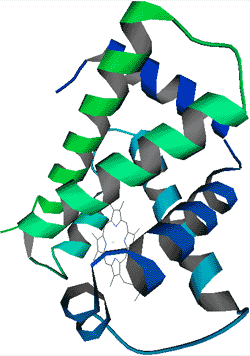 Ribbon diagram of hemoglobin |
ProteinsMost people know that muscles are mainly built up by proteins. But that is just one of many tasks proteins have in our body. In fact, everything we do - think, laugh and run - emerges from the coordinated activities of a lively, intercommunicating society of protein molecules. Proteins are the building blocks of all cells and execute nearly all cell functions. The multiplicity of functions performed by proteins arises, from the huge number of different three-dimensional shapes they adopt. Structurally, proteins are polymers of amino acids, joined together by peptide bonds in a long chain, also called a polypeptide chain. Some proteins consist of more than one polypeptide chain and they frequently associate with each other to form larger protein complexes. Human proteins are composed of only 20 different kinds of amino acids, ten of which our body can produce by itself (non essential amino acids) and ten that must be provided through food (essential amino acids). Each type of protein has its own unique sequence of amino acids; this sequence, known as its primary structure, actually determines the shape (secondary and tertiary structure) and function of the protein. The synthesis of these multifunctional molecules is called translation »
|